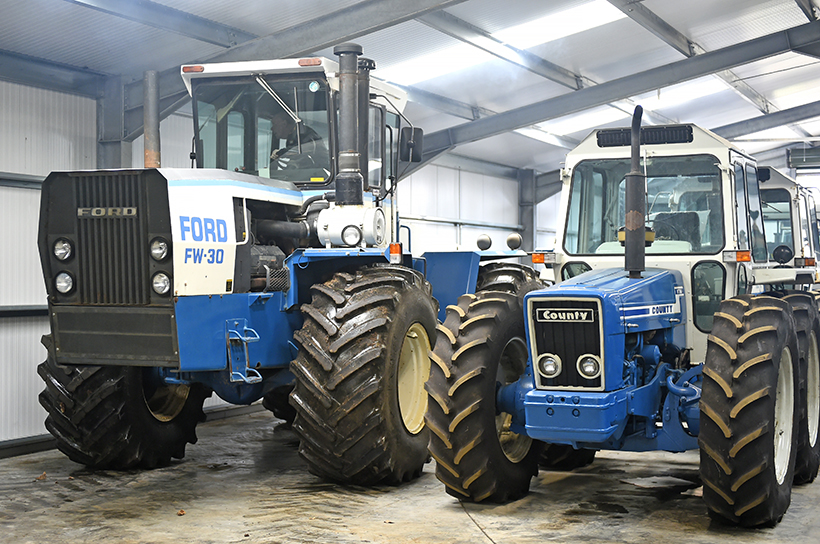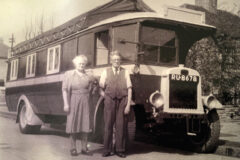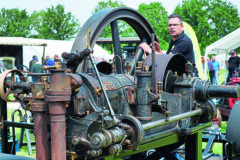Incredibly rare 1981 Ford FW-30
Posted by Chris Graham on 20th April 2023
Chris Graham talks to Tim Pearman about his giant Ford FW-30 and the chance encounter that led him to realise a boyhood dream.

A very rare sight! Tim Pearman’s 1981 FW-30 is one of only 145 Ford FW Series tractors that were officially imported into the UK between 1978 and 1985.
Tractors don’t come much bigger than Ford’s mighty FW Series machines, although your chances of seeing one out and about in the UK are sadly slim. So you can imagine my excitement at the prospect of getting a close look at Tim Pearman’s 1981 FW-30, which has actually been part of his extensive tractor collection for nearly two decades.
I first spotted this awesome machine grinding its way around the packed arena at last summer’s Great Dorset Steam Fair, after which Tim kindly agreed to having its story featured in this magazine. With only 145 of these blue and white giants having been officially imported into the UK during the late 1970s and early ‘80s, they’re an understandably rare sight today. I visited Tim’s Worcestershire home the day before the Tractor World Show at Malvern, and our plans were nearly scuppered by snow. Thankfully, an early-morning thaw allowed us to rouse the beast from its slumbers and take some photographs outside, albeit under a leaden sky.
Chance encounter
“I bought my FW-30 back in 2005, having found it completely by chance,” Tim explained. “I was tipping soil on a farm near Pershore, in Worcestershire, and happened to spot the tractor parked against a hedge and obviously very neglected. There was a window missing from the cab, brambles were growing through the structure and the whole machine was surrounded by a sea of nettles. Nevertheless, I knew exactly what it was and, having beaten a path to it through the undergrowth, went in for a closer look.

Designed and built for the wide open prairies of the United States, the FW-30 is powered by a 14.7-litre Cummins V8 diesel engine that pumps out nearly 300hp.
“I have enduring memories of two FW-30s working locally on farms when I was a boy, and they made a real impression on me. This was back in the late 1970s and they were a fantastic sight, compared to the sort of tractors I was used to seeing. In those days, most farms were still running machines like the Massey Ferguson 165, so you can imagine how big and loud those giant Fords appeared to me then.
“I’ve been into tractors for as long as I can remember, really, and was out working on a hire digger – and baling – by the time I was 13. My dad was an agricultural contractor using mainly International machinery, so he started sending me out as soon as he knew I was capable of doing the job. Then I started my own contracting company in 1986, using an International 956, but soon swapped that for a 1981 Ford TW-10 4WD. I remember that tractor had a terrible gearbox, but was a great workhorse overall. In fact, it was that model that first fired my interest in the blue and white machines. I was using that TW-10 as the towing tractor on the day I came across the abandoned FW-30.”
Immediately tempting
Tim remembers being immediately tempted by the sight of the neglected monster, but slightly nervous about it, too. “I recognised it immediately – of course – and was instantly interested but, at the back of my mind, I was already worrying about what costs might be involved in fixing it. I could imagine it costing a fortune to put right.

The fact that this tractor is articulated means that it’s a lot more manoeuvrable than you might imagine, given its overall size. If you can get the front wheels through a gap, the rear will simply follow the same path.
“The farmer told me that he’d bought a Case to replace the FW-30 and, once the new machine arrived, he’d simply parked the Ford in a quiet corner and left it to rot. So, acting on the spur of the moment, I offered him £3,000 for it there and then, but he refused, so we left it at that. I continued thinking about it over the following days, though, and then spotted a magazine advert from a Scotch Corner-based company that specialised in selling American tractors. Amazingly, they had an FW-30 among their stock for £13,000, so I went to have a look. What I found was a tractor in quite a state. It was a bit of a shed, to be honest and I was surprised they were asking such a high price. It had been hand-painted, wouldn’t drive in top gear, the clutch was on the way out and the battery was contained in a wooden box that had been bolted onto the side of the body! However, the fact that it was listed at £13,000 made me determined to have another go at the Worcestershire machine.
“So I went back to the farmer, offered him an extra thousand and, rather surprisingly, he accepted, so I’d got myself a very original but down-at-heel FW-30 for £4,000, and I was very happy! Luckily, I had a friend with an artic who agreed help me bring the tractor home, but I had to get it onto the low-loader first. I had no experience of driving a tractor like this and, although the engine started very easily, I soon discovered that the brakes were shot and the clutch was on its last legs. However, the biggest surprise came when I discovered the unusual way in which the accelerator pedal operated; pressing it didn’t increase engine revs, it decreased them! So, the engine continues to run at whatever revs have been set using the hand throttle lever, until the ‘accelerator’ pedal is pressed.”

It’s quite a climb up and down from the FW’s cab. The thickness of metal used throughout means that everything is remarkably sturdy.
We have ignition…
But that wasn’t the only engine-related oddity that Tim discovered during his initial drives around the farm, before attempting to get the FW onto the low-loader. “I also found that the ignition key worked unlike any other that I’ve ever used before. Turning it to the ‘Off’ position made not a scrap of difference to the engine, which kept running at the speed set by the hand throttle. To actually stop the engine you have to give the hand throttle a tweak to blip the engine revs, after which the Cummins V8 falls silent.
“So you can imagine that all these factors created quite a problem for me as I was manoeuvring this large machine onto the low-loader; no brakes, a dodgy clutch and an engine that has to be revved to switch it off! I had to time it all just right, to avoid running up over the trailer’s swan neck, and on into the back of the tractor unit, which would have been an expensive disaster. Fortunately, I managed to get everything right and, after securing the tractor, we set off for home.
“Once back and unloaded, the first decision that needed to be made concerned how best to tackle the work needed. After a little thought, I decided to entrust it to a local Ford tractor dealership in Evesham, and allow the expert technicians there to work through the FW, bringing everything back to running order as they went. But that decision turned out to be a bit of a mistake. Over a frustratingly long length of time, the workshop managed to fix the clutch, get the brakes working and tackle a few other jobs, after which I was presented with a bill for £8,000!

Typically 1970s-style dashboard layout. Contrary to the advice on the yellow sticker, a quirk of this model is that the ignition switch doesn’t actually turn off the engine!
“This came as quite a shock, especially when I discovered that they hadn’t even needed to fit a new clutch. Simply replacing the master and slave cylinders was all that had been necessary to get the clutch properly operational again. Admittedly, the parts had to sourced from America but, all the same, I wasn’t best pleased. Looking back on it now, I certainly paid a lot of money for not a great deal of benefit, but you live and learn!”
Pros and cons
“Once I finally had the tractor home again, and was able to start enjoying it, I discovered that – despite all the money spent – the brakes aren’t particularly great, and nor is the clutch or the gearbox; but I think that’s just a characteristic of the model, not a problem with this particular tractor. It’s not what I’d call a ‘friendly’ tractor to drive, especially given the awkwardly-short gear selector lever and the ‘odd’ throttle pedal.

Tim Pearman first saw and admired the FW-30 as a boy, so eventually getting to climb this impressive ‘staircase’ up the cab on his own example, is a dream come true.
“The furthest I’ve driven it on the road was a 25-mile run from home to the Tractor World Show at Malvern and, while it all went smoothly enough, I was certainly glad to get off the thing at the other end! The UK’s roads certainly aren’t the FW-30’s natural habitat; it’s a tractor that was designed for working in the wide open spaces of the American prairie lands. I can imagine it working perfectly in that sort of environment, where there’s plenty of time and space to make manoeuvres.
“Nowadays I tend to drive it using the hand throttle only, because I still find the pedal very unintuitive to use. Presented with a hazard on the road, the natural inclination is to take your foot off the accelerator pedal and go for the brake. But in this case, though, all that does is increase the speed of the engine, which can be extremely unnerving if you’re not expecting it!”

The shortness of the gear selector lever makes it awkward to reach and use. An odd design decision. This tractor has run for about 6,000 hours from new.
I was keen to find out if Tim has done much work with the TW, and put its impressive power and weight to the test. “To be honest, I haven’t worked the tractor a great deal in the time I’ve had it,” he explained. “It has been used to pull a set of discs, though, and for some mole ploughing, and it excelled at both tasks. It’s certainly an impressive tractor in the field, and its power and weight make it a great lugger. It’s also surprising how little effect it has on the ground – even with single wheels fitted – considering its weight.
“I think that even by today’s standards, the FW-30 represents a pretty impressive performer, for the money. I mean, what other 300hp tractor of this size can you get for about £20,000? It certainly provides a cheap way of turning the ground over on a big scale.”
Further thoughts
“I think that the basic design of the tractor is very good. It has a really strong and durable chassis, and the thickness of metal used everywhere is very impressive – you can jump up and down on the bonnet and mudguards without it having any effect! It’s a fundamentally simple tractor so there’s not a lot to go wrong. It’s fitted with an engine and gearbox from the trucking industry, so both are tried and tested. Everything’s very straightforward and I enjoy the fact that it comes from an era when components were still being over-engineered to guarantee longevity. Tractors just aren’t built like this anymore.”

You can’t fully appreciate the sheer size of the FW until you put a man in the picture. Tim is a big fan and has owned this giant tractor for 18 years.
As if to back up the FW-30’s inherent ruggedness, Tim confirmed to me that the engine hasn’t required anything other than the most basic or attention during the 18 years he’s owned it. “In fact, I can’t remember having had to do anything on the repair front during that time; it’s never let me down or failed to start. Of course, it’s a massive bonus that it comes from the pre-electronics age, so the electrical side of things is simplicity itself – no delicate ECUs or sensors to cause trouble!
“I was attracted to the model primarily because of its impressive size, and it’s certainly lived up to my expectations. It’s a fun machine to use and never fails to attract attention, wherever it goes. The cab is decent, reasonably comfortable and quiet in use. The one downside is the ergonomics of the control set-up. The short gearlever – located on the floor between the driver’s legs – is a real pain to use, but that’s just how it is.”

The FW-30 is a fantastic pulling tractor with its power, weight and traction ensuring it can operate an eight- or 10-furrow plough with ease.
Surprisingly manoeuvrable
“I don’t find it a daunting tractor to drive, despite its size. The articulation actually makes it surprisingly manoeuvrable and, of course, the high seating position ensures good, all-round visibility. You can place the front end quite precisely and don’t have to worry about cutting corners with the rear, as those wheels simply follow in the tracks of the fronts. The turning circle is amazingly good, too. The tractor is 6.78m long, but is capable of turning itself around in just 6m!
“I’ve let a number of people drive it over the years, and most people’s verdict is that they wouldn’t want to spend too much time in it, due to the quirky controls. However, I think that regular use would quickly bring familiarity so that, in the right situation, the FW-30 would be a pleasure to operate. It’s designed for use in enormous fields, so expecting it to perform well in anything other than that environment really isn’t fair.

The FW-30 has proved remarkably reliable in Tim’s ownership. All it’s cost him is a pair of rear tyres (£1,500 each!) which, amazingly, were fitted by an experienced technician, single-handedly!
“I’ve taken part in a couple of tractor-pulling events over the years which have been both fun and interesting. On one occasion the ground was wet and the various, highly-modified Fordson Majors – such a favourite at these events – couldn’t even move the sledge. But the standard FW had no trouble. I simply hooked it up, selected third gear and away we went, towing the sledge all the way to the end of the track. I suppose that’s the result of having an engine that produces plenty of power in a tractor that weighs nearly as much as the sledge being pulled. It was great fun and a perfect illustration of the potential this amazing machine truly has!”
FORD FW-30 SPECS (UK)
Engine Cummins V8
Capacity 14.7-litres
Power 295hp
Torque 700lb/ft (849Nm)
@ 1,800rpm
Bore x stroke 5.5×4.75in (140x121mm)
Rated speed 2,600rpm
Transmission Spicer manual, 20 fwd, 4 rev
Fuel tank 187 gallons (850 litres)
Engine oil 7.8 gallons (35.5 litres)
Coolant capacity 14 gallons (63.6 litres)
Total weight 25,320lb (11,485kg)
FORD FW SERIES FACTS
- All FW Series tractors were built for Ford Tractor Operations by Steiger, based in Fargo, North Dakota
- Following its 1977 American launch, just 145 FWs found their way to the UK between 1978 and 1985
- Imported models had to be adapted for the UK and this homologation work was carried out by Basildon-based SEM Engineering
- The first tractor to arrive in the UK took 12 weeks to get to Liverpool docks, aboard the Atlantic Conveyor (later sunk during the Falklands War, in 1982)
- Safety-related additions for UK market included: Emergency handbrake, direction indicators, front and rear sidelights, reflectors, rear view mirrors, numberplate light, radiator and cooling fan/belt shrouds, safety decals inside the cab, exhaust silencer, increased hydraulic lift capacity, rear linkage modifications, fuel pump recalibration
- UK list price for an FW-30 in 1978 was £40,480
- First UK FW Series tractor was sold to L Van Geest Farms, in South Lincolnshire
- Eight- or 10-furrow ploughs for FW tractors in the UK were supplied by Dowdeswell
- Cultivators were developed by Sleaford-based Simba International, while Keeble Brothers from Chelmsford produced sub-soilers
- The 335hp FW-60 models was introduced to the UK market in 1980, with a price tag of £44,500.
- A Cummins straight-six-powered, 325hp revamped version of the FW-60 launched in 1985 and, a year later, got the option of an Allison, 10-speed automatic transmission
- FW Series tractors were sold in Essex, Oxfordshire, Yorkshire and Scotland, but the majority went to farms in Lincolnshire
This feature comes from the latest issue of Ford & Fordson Tractors, and ylou can get a money-saving subscription to this magazine simply by clicking HERE

Previous Post
Amazing 94-year-old Leyland Lion bus still running

Next Post
Rare Belgian-built Bollinckx engines



